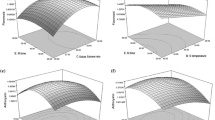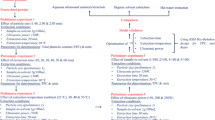Abstract
Conventional extraction techniques require high consumption of available resources and thus are ineffective and expensive, especially at an industrial scale. The aim of the study was to optimize the ultrasound-assisted extraction of polyphenols from fresh wheatgrass (Triticum aestivum L.). The effects of different extraction techniques and solvents were investigated on the yield of extractive substances and antioxidant activity. The ultrasound-assisted extraction technique and ethanol gave the highest yield of extractive substances so that they were used in the optimization studies. The central composite design was employed to find the optimal levels of ethanol concentration, extraction temperature, and extraction time. The total phenolic content was varied in the range of 10.50–15.50 grams of gallic acid equivalents per 100 g of dry weight of plant material (g GAE 100 g−1 dw). The optimal conditions for ultrasound-assisted extraction were: (1) 56% (v/v) ethanol, (2) temperature of 59 °C, and (3) extraction time of 28 min. The results of ANOVA indicated that the highest impact had the extraction temperature on the total phenolic content. The toxic solvents were not used in the developed extraction procedure. The consumption of energy and raw plant material is estimated to be lower by at least 10% compared to conventional techniques.

Similar content being viewed by others
Abbreviations
- DPPH:
-
2,2-diphenyl-1-picrylhydrazine
- BHT:
-
Butylhydroxytoluene
- UAE:
-
Ultrasound-assisted extraction
- CCD:
-
Central composite design
- TPC:
-
Total phenolic content
- FEP:
-
Fast extraction period
- EE:
-
Extraction efficiency
- ANOVA:
-
Analysis of variance
- GAE:
-
Gallic acid equivalents
- dw:
-
Dry weight of plant material
- df:
-
Degree of freedom
- SS:
-
Sum of squares
- MS:
-
Mean squares
- Std. dev.:
-
Standard deviation
References
Bar-Sela G, Cohen M, Ben-Arye E, Epelbaum R (2015) The medical use of wheatgrass: review of the gap between basic and clinical applications. Mini Rev Med Chem 15(12):1002–1010
Byers T, Nestle M, McTiernan A, Doyle C, Currie-Williams A, Gansler T, Thun M (2002) American cancer society guidelines on nutrition and physical activity for cancer prevention: reducing the risk of cancer with healthy food choices and physical activity. CA Cancer J Clin 52(2):92–119
Chon SU, Heo BG, Park YS, Kim DK, Gorinstein S (2009) Total phenolics level, antioxidant activities and cytotoxicity of young sprouts of some traditional Korean salad plants. Plant Foods Hum Nutr 64:25–31
Cui Q, Liu J, Xu W, Kang YF, Wang X, Li Y, Fu Y (2019) Enhanced extraction and preconcentration of main target saponins from Panax notoginseng root using green and efficient formulated surfactant aqueous systems. J Clean Prod 210:1507–1516
d’Alessandro LG, Kriaa K, Nikov I, Dimitrov K (2012) Ultrasound assisted extraction of polyphenols from black chokeberry. Sep Purif Technol 93:42–47
Dent M, Dragovic-Uzelac V, Penic M, Brncic M, Bosiljkov T, Levaj B (2015) The effect of extraction solvents, temperature and time on the composition and mass fraction of polyphenols in Dalmatian wild sage (Salvia officinalis L.) extracts. Food Technol Biotechnol 51(1):84–91
Devi CB, Bains K, Kaur H, Sangha MK (2017) Comparison of ascorbic acid, beta-carotene, chlorophyll and antioxidant activity of fresh and dry wheatgrass (Triticum aestivum L.). Appl Biol Res 19(3):336–341
Durairaj V, Hoda M, Shakya G, Babu SPP, Rajagopalan R (2014) Phytochemical screening and analysis of antioxidant properties of aqueous extract of wheatgrass. Asian Pac J Trop Med 7:S398–S404
Ghafoor K, Choi YH, Jeon JY, Jo IH (2009) Optimization of ultrasound-assisted extraction of phenolic compounds, antioxidants, and anthocyanins from grape (Vitis vinifera) seeds. J Agric Food Chem 57:4988–4994
Gore RD, Palaskar SJ, Bartake AR (2017) Wheatgrass: green blood can help to fight cancer. JCDR 11(6):ZC40–ZC42
Gruenwald J, Brendler T, Jaenicke C (2004) PDR for herbal medicines, 3rd edn. Thomson PDR, Montvale
He B, Zhang LL, Yue XY, Liang J, Jiang J, Gao XL, Yue PX (2016) Optimization of ultrasound-assisted extraction of phenolic compounds and anthocyanins from blueberry (Vaccinium ashei) wine pomace. Food Chem 204:70–76
Jamshidi M, Ghaedi M, Dashtian K, Ghaedi AM, Hajati S, Goudarzi A, Alipanahpour E (2016) Highly efficient simultaneous ultrasonic assisted adsorption of brilliant green and eosin B onto ZnS nanoparticles loaded activated carbon: artificial neural network modeling and central composite design optimization. Spectrochim Acta A 153:257–267
Kakkar A, Dubey PK (2012) Microwave assisted isolation and evaluation of chlorophyll from wheatgrass and study on its antimicrobial activity. IJPRD 4(8):142–145
Kiani H, Sun DW (2018) Numerical simulation of heat transfer and phase change during freezing of potatoes with different shapes at the presence or absence of ultrasound irradiation. Heat Mass Transf 54:885–894
Kulkarni SD, Tilak J, Acharya R, Rajurkar NS, Devasagayam TPA, Reddy AVR (2006) Evaluation of the antioxidant activity of wheatgrass (Triticum aestivum L.) as a function of growth under different conditions. Phytother Res 20(3):218–227
Moller JK, Madsen HL, Aaltonen T, Skibsted LH (1999) Dittany (Origanum dictamnus) as a source of water-extractable antioxidants. Food Chem 64(2):215–219
Molyneux P (2004) The use of the stable free radical diphenylpicrylhydrazyl (DPPH) for estimating antioxidant activity. Songklanakarin J Sci Technol 26:211–219
Mondal P, Purkait MK (2018) Green synthesized iron nanoparticles supported on pH responsive polymeric membrane for nitrobenzene reduction and fluoride rejection study: optimization approach. J Clean Prod 170:1111–1123
Niroula A, Khatri S, Khadka D, Timilsina R (2019) Total phenolic contents and antioxidant activity profile of selected cereal sprouts and grasses. Int J Food Prop 22(1):427–437
Paunović DĐ, Mitić SS, Stojanović GS, Mitić MN, Stojanović BT, Stojković MB (2015) Kinetics of the solid-liquid extraction process of phenolic antioxidants and antioxidant aapacity from hop (Humulus lupulus L.). Sep Sci Technol 50(11):1658–1664
Popov S, Abdel-Fattah T, Kumar S (2016) Hydrothermal treatment for enhancing oil extraction and hydrochar production from oilseeds. Renew Energ 85:844–853
Rajoria A, Mehta A, Mehta P, Ahirwal L, Shukla S, Bajpai VK (2017) Evaluation of antiproliferative and hepatoprotective effects of wheat grass (Triticum aestivum). Acta Biol Hung 68(2):150–161
Ramandi NF, Ghassempour A, Najafi NM, Ghasemi E (2017) Optimization of ultrasonic assisted extraction of fatty acids from Borago Officinalis L. flower by central composite design. Arab J Chem 10:S23–S27
Rimple KM, Kumar R, Newton A, Reeta HS (2016) Poly pharmacological effects of green blood therapy: an update. WJPMR 2(1):10–21
Samadi M, Abidin ZZ, Yunus R, Biak DRA, Yoshida H, Lok EH (2017) Assessing the kinetic model of hydro-distillation and chemical composition of Aquilaria malaccensis leaves essential oil. Chin J Chem Eng 25(2):216–222
Savic IM, Nikolic VD, Savic-Gajic IM, Nikolic LB, Moder K, Hopkins M (2016) Optimization of quercetin extraction from green tea (Camellia sinensis) using central composite design, and the pharmacological activity of the extract. Chem Biochem Eng Q 30(1):103–115
Shakya G, Balasubramanian S, Hoda M, Rajagopalan R (2017) Inhibition of metastasis and angiogenesis in Hep-2 cells by wheatgrass extract-an in vitro and in silico approach. Toxicol Mech Methods 28(3):205–218
Singh N, Verma P, Pandey BR (2012) Therapeutic potential of organic Triticum aestivum Linn (Wheat Grass) in prevention and treatment of chronic diseases: an overview. Int J Pharm Sci Drug Res 4(1):10–14
Singleton VL, Orthofer R, Lamuela-Raventós RM (1999) Analysis of total phenols and other oxidation substrates and antioxidants by means of Folin-Ciocalteu reagent. Methods Enzymol 299:152–178
Suriyavathana M, Roopavathi I (2016) Phytochemical characterization of Triticum Aestivum (Wheat Grass). J Pharmacogn Phytochem 5(1):283–286
Tandon S, Arora A, Singh S, Monga J, Arora S (2011) Antioxidant profiling of Triticum aestivum (Wheatgrass) and its antiproliferative activity in MCF-7 breast cancer cell line. J Pharm Res 4:4601–4604
Vega AJD, Hector RE, Jose LGJ, Paola HC, Raúl ÁS, Enrique OVC (2017) Effect of solvents and extraction methods on total anthocyanins, phenolic compounds and antioxidant capacity of Renealmia alpinia (Rottb.) Maas peel. Czech J Food Sci 35(5):456–465
Vinatoru M, Mason TJ, Calinescu I (2017) Ultrasonically assisted extraction (UAE) and microwave assisted extraction (MAE) of functional compounds from plant materials. TrAC Trends Anal Chem 97:159–178
Zendehbad SH, Mehran MJ, Sudhakar M (2014) Flavonoids and phenolic content in wheat grass plant (Triticum aestivum). Asian J Pharm Clin Res 7(4):184–187
Acknowledgements
This research was funded by the Ministry of Education, Science and Technological Development of the Republic of Serbia.
Author information
Authors and Affiliations
Corresponding author
Ethics declarations
Conflict of interest
The authors declare that they have no conflict of interest.
Additional information
Publisher's Note
Springer Nature remains neutral with regard to jurisdictional claims in published maps and institutional affiliations.
Electronic supplementary material
Below is the link to the electronic supplementary material.
Rights and permissions
About this article
Cite this article
Savic, I.M., Savic Gajic, I.M. Optimization of ultrasound-assisted extraction of polyphenols from wheatgrass (Triticum aestivum L.). J Food Sci Technol 57, 2809–2818 (2020). https://doi.org/10.1007/s13197-020-04312-w
Revised:
Accepted:
Published:
Issue Date:
DOI: https://doi.org/10.1007/s13197-020-04312-w




